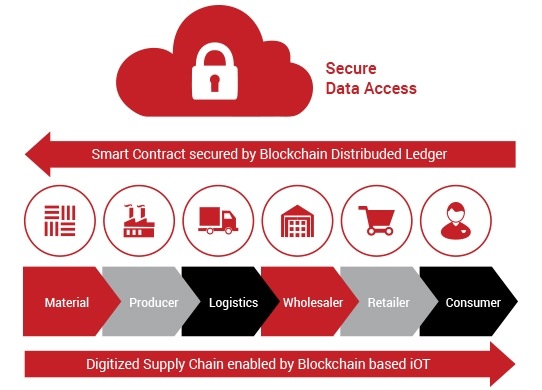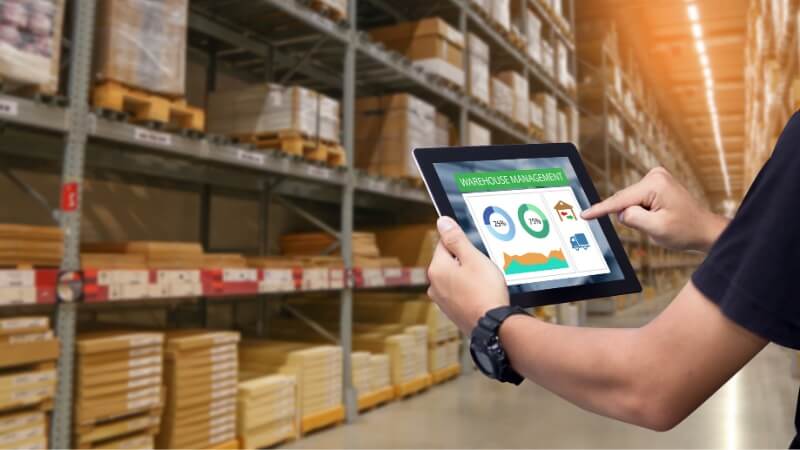As per Gartner, through 2025, 50% of large global companies will be using AI, advanced analytics and IoT in supply chain and logistics operations. IoT devices have completely transformed Supply Chain Management both in terms of its operational efficiencies and revenue opportunities by making it more transparent. Modern supply chains not only enable you to keep track of your products but also allow you to gain an edge over your competitors. Leveraging IoT in supply chain, logistics and warehouse management makes it much easier to locate your goods, track their movement, identify where and when they are delayed in transit and plan alternative routes, monitor their storage conditions (temperature, humidity etc.), and estimate when they will arrive at a specific location.
With so many moving parts in modern supply chains, inventory visibility – knowing how much inventory you have and its movement along your supply chain is more essential than ever before. IoT devices comes with features like asset tracking, inventory planning and predictive maintenance to help you keep track of all the goods and inventory that your company has in stock. These in turn helps in better utilization of warehouse resources and capital.

Applications of IoT in Supply Chain Management
Asset Tracking and Tracking
Traditionally, asset-intensive sectors like manufacturing, energy and utilities have been facing warehouse management challenges with in terms of product deliveries, inventory theft and loss and damaged goods. IoT devices and sensors replace traditional asset tracking methods like tracking numbers and bar codes, providing the ability to track and manage goods throughout the supply chain. IoT devices can identify where and when goods are delayed in transit allowing for contingency planning and alternative routes to speed up the supply chain. Businesses can also use these sensors in supply chain and logistics management to gain granular data like the temperature at which a product was stored, how long it spent in transit, and when it was sold. This type of data gained from IoT technology can help companies focus on high level aspects of supply chain such as quality control, on-time deliveries, and improve forecasting. Monitor transactions and movement of assets or goods across trading partners and organizations. With IoT asset tracking and blockchain-enabled tracing, you can create a digital trail of each step and securely record business transactions across your supply chain.
Returnable Assets Monitoring
IoT-based supply chain devices can help you track reusable shipping assets wherever they go across facilities and even across geographies. Businesses can track assets in real-time to immediately identify and initiate the recovery of missing or stolen containers, even if they are in transit. You can analyze missing assets to identify theft, pilferage, or misappropriation patterns by location, transporter, vendor, or customer. You can leverage predictions, data trails, instant alerts, and asset routing automation to speed up asset recovery and conflict resolution
Real-Time Inventory Tracking
IoT-based, real-time inventory tracking provides accurate, end-to-end visibility to raw materials, work-in-progress, and finished goods. IoT sensors track inventory in real-time across categories, product types, zones, facilities, and geographies – providing better insights into key metrics such as inventory utilization and warehouse space utilization. You can improve stocking efficiencies by knowing and forecasting what inventory they need, where they need it when they need to stock up, and when they’ll face a shortage. IoT-based inventory tracking helps you track the real-time location, condition, utilization, handling, and chain of custody for inventory across the globe and quickly respond to instances of theft or misuse.
Demand Forecasting and Inventory Planning
Many manufacturers, distributors and logistics companies are using outdated forecasting methods to develop business strategies. IoT sensors collect data on usage and buying patterns, giving product manufacturers the ability to evolve from traditional forecasting to planning based on actual consumption. Information is readily available for key decision making as you can track your inventory including existing supplies, at the click of a button. All this data which acts as inputs to advanced analytics can be used to discover trends and patterns to make manufacturing schedules more efficient, and making sure that brands sell as much as possible without oversaturating the market.
Real-time Supply Chain Visibility
End-to-end visibility across supply chains is becoming increasingly complex due to the number of parties involved. In order to respond effectively to supply chain logistics disruptions, companies should be able to validate and analyze data across the supply chain before they can respond. IoT devices can track the status of goods as they move through the supply chain and ensure that all parties in the supply chain are able to access the data in real time, track the status, prepare for shipping and execute transactions. All of this can be done via a combination of IoT and blockchain technology. This information can also be combined with third-party data sources, allowing companies to react quickly to unexpected supply chain events such as supply disruption or a sudden dip in customer demand.
Global Supply Chain Finance
Global supply chain typically include cross-border transactions, causing delays, because they involve multiple parties, international payments, local banking regulations, and heavy paperwork. Any discrepancies, such as duplicate invoices, can cause significant delays in clearing the payments. IoT and blockchain together could speed up the movement of goods across borders, resulting in secure, efficient, and cheaper transactions that prevent fraud through a distributed ledger that cannot be manipulated. With blockchain-powered smart contracts, companies can eliminate the need to reconcile documents across multiple parties. They can monitor the shipment status and execute the payment terms of the contract upon delivery.
Connected Fleets
While IoT can optimize the management of fixed assets such as machinery and equipment, it also improves the management of assets that are in motion – such as cars, trucks, ships, and autonomous vehicles. Ensuring that the entire fleet, be it shipping containers, suppliers’ delivery trucks, or your delivery vans are connected, allows you to gain better visibility into the supply chain, lowering transportation costs, increasing fleet efficiency, and improving customer service by ensuring on-time delivery.
Accurate Records
Having better visibility into your supply chain can help you get the right products in the right place at the right time. Keeping detailed records of inventory lots can help you avoid unpleasant incidents such as finding out that an entire batch of product or the raw material is expired or about to expire. Integrating IoT with your supply chain management software can help manufacturers track and manage inventory from the time of receipt through production and shipping while maintaining accurate product information and traceability for future analysis.
Predictive Maintenance
Preventive maintenance seeks to decrease the likelihood of a machine’s failure by ensuring regular maintenance whereas IoT-enabled predictive maintenance leverages sensor data to determine the likelihood of equipment failure or breakdown before it occurs. With the ability to process large amounts of data and run sophisticated algorithms, IoT-enabled predictive maintenance allows companies to identify and predict potential failures before they occur and increase the productivity of critical assets. Companies can use IoT sensors in their high-value equipment and machinery to ensure timely preventive and predictive maintenance, avoiding unplanned downtime that increases costs.
Regulatory Compliance
In highly regulated industries such as food and pharmaceuticals, products need to be transported under strictly controlled temperature ranges and within specific time windows. Manufacturers and distributors need to be able to provide proof of compliance and failing to do so can cause high-value shipments to be delayed or seized by the authorities for investigation. An IoT and blockchain based framework can guarantee the reliability and security of information and provide evidence of regulatory compliance. Combining IoT and blockchain also enables suppliers to specify compliance conditions in a smart contract, ensuring the flow of reliable information across the supply chain.
Vendor Relationships
Supply chain management requires cooperation and collaboration between you and your vendors. IoT data allows companies to change business strategies quickly by modifying their own production schedules, and identifying underperforming vendors that are costing them money. You can analyze how your vendors are handling the supply chain logistics, and how they’re handling your product once it’s manufactured. Higher quality goods mean better relationships with customers and better customer retention overall.
Customer Support
IoT devices and sensors can be integrated with your applications, generating enough data to fundamentally change the nature of field service, customer support and end-user training. For example, rather than forcing a field worker to call a help desk when a piece of equipment fails, you can deploy IoT applications and solutions that enable the field worker to identify the issue and resolve it – in many cases without help desk intervention. That can reduce downtime and customer support costs while increasing user productivity. At the same time, companies can gather real-time data about the performance and reliability of their assets, which can be used to improve their design.
Note: This article was originally published in November 2019



